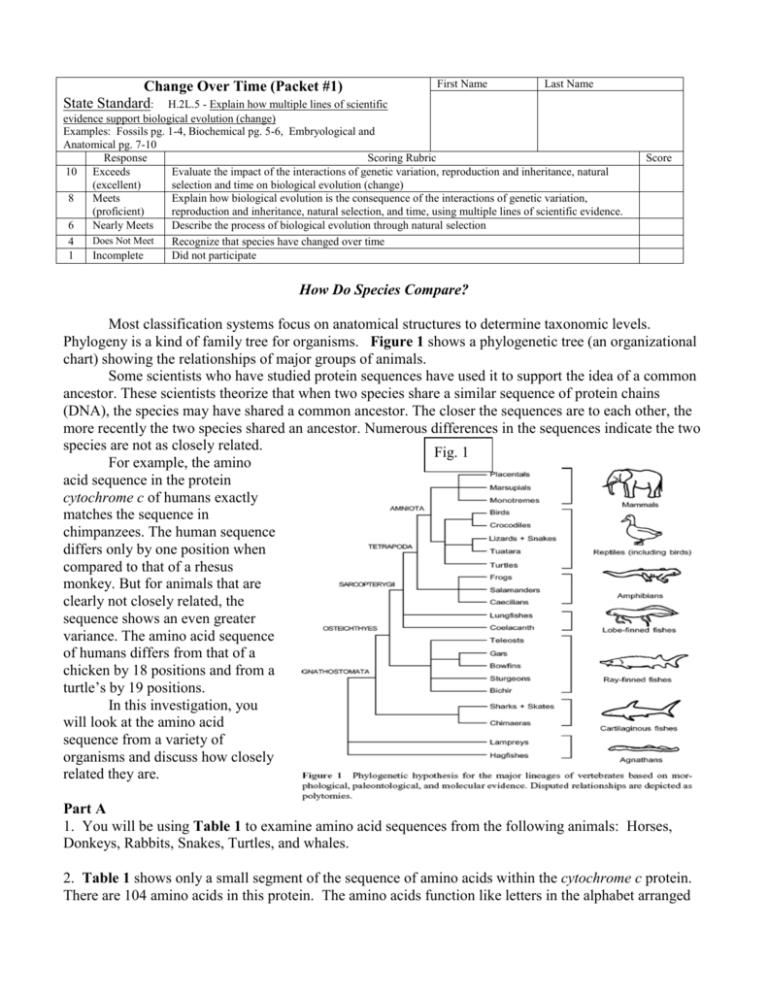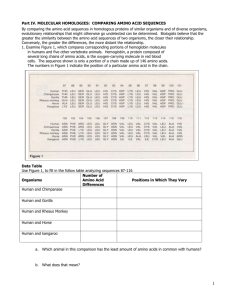How do species compare?
advertisement

Change Over Time (Packet #1) State Standard: H.2L.5 - Explain how multiple lines of scientific First Name Last Name evidence support biological evolution (change) Examples: Fossils pg. 1-4, Biochemical pg. 5-6, Embryological and Anatomical pg. 7-10 Response Scoring Rubric 10 Exceeds Evaluate the impact of the interactions of genetic variation, reproduction and inheritance, natural (excellent) selection and time on biological evolution (change) 8 Meets Explain how biological evolution is the consequence of the interactions of genetic variation, (proficient) reproduction and inheritance, natural selection, and time, using multiple lines of scientific evidence. 6 Nearly Meets Describe the process of biological evolution through natural selection Does Not Meet 4 Recognize that species have changed over time 1 Incomplete Did not participate Score How Do Species Compare? Most classification systems focus on anatomical structures to determine taxonomic levels. Phylogeny is a kind of family tree for organisms. Figure 1 shows a phylogenetic tree (an organizational chart) showing the relationships of major groups of animals. Some scientists who have studied protein sequences have used it to support the idea of a common ancestor. These scientists theorize that when two species share a similar sequence of protein chains (DNA), the species may have shared a common ancestor. The closer the sequences are to each other, the more recently the two species shared an ancestor. Numerous differences in the sequences indicate the two species are not as closely related. Fig. 1 For example, the amino acid sequence in the protein cytochrome c of humans exactly matches the sequence in chimpanzees. The human sequence differs only by one position when compared to that of a rhesus monkey. But for animals that are clearly not closely related, the sequence shows an even greater variance. The amino acid sequence of humans differs from that of a chicken by 18 positions and from a turtle’s by 19 positions. In this investigation, you will look at the amino acid sequence from a variety of organisms and discuss how closely related they are. Part A 1. You will be using Table 1 to examine amino acid sequences from the following animals: Horses, Donkeys, Rabbits, Snakes, Turtles, and whales. 2. Table 1 shows only a small segment of the sequence of amino acids within the cytochrome c protein. There are 104 amino acids in this protein. The amino acids function like letters in the alphabet arranged perfectly to spell a word. If the amino acid sequence changes, the word changes or in this case the protein changes to fit the needs for the organism. Table 1 shows the sequence between positions 39 and 53. 3. Use the characteristics of the animals, such as appearance, habitat, or diet, for example, to make a prediction as to which of them are most closely related. Fill out the table 2 in the Data and observations 4. Indicate which animals you think are the least closely related. Part B 1.Compare the amino acid sequence of the horse to the rest of the animals. How many amino acids differ between the species? Record your results in Table 2. 2.Study the relationship between the species indicated in the first column of Table 2. What species share the most similar sequence with a horse? __________________________________________________ 3. Which species have sequences that are dissimilar?_______________________________________ Table 1 Position of the amino acid Horse 39 Position of the Amino Acids in Cytochrome c 40 41 42 43 44 45 46 47 48 49 A B C D E F G H I J K L M N O Whale A B C D E Y G H Z J K L M N O Turtle A B C D E V G H Z J K U M N O Rabbit A B C D E Y G H Z J K L M N O Donkey A B C D E F G H Z J K L M N O Snake A B C D E V G H Z J K W M N O Position of the amino acid 39 40 41 42 43 44 45 46 47 48 49 50 51 52 53 50 51 52 53 Data and Observations 1. Fill out table 2 Animal Appearance (describe feet) Table 2 Habitat (biome) Diet Number of Amino Acid positions different from horse Skin covering Horse Whale Turtle Rabbit Donkey Snake 2. In the space below, construct cladogram (a branching tree) using the information you’ve gathered. Your cladogram should include the animals in the study and how closely related they are to the horse. horse Analyze and Conclude 1. Which species are closest to a horse as indicated by the particular sequences of amino acids? 2. Which species are more distantly related to a horse as indicated by the sequence of amino acids in Table 1? 3. Based on the evidence in table 2, how would you describe species with similar amino acid sequences in terms of their shape and structure? 4. Based on table 2, make a general statement about whether any of the species other than horses are more or less similar to each other. 5. Currently, scientists are moving away from the traditional method of grouping organisms based on comparative anatomy. What methods are they using today to classify organisms (Hint: what evidence did you use biotechnology to attain?). 6. Cytochrome c is just one strand of amino acids. Your body is programmed with thousands (about 60,000) of these genes. What life molecule is the “program for life”? ____________ What is it’s code? ______-________ and ______-________







